Experimental Investigation on Wall Film Distribution of Dimethyl Ether/Diesel Blended Fuels Formed during Spray Wall Impingement
Abstract
:1. Introduction
2. Experimental Apparatus and Procedures
2.1. Apparatus and Materials
2.1.1. Constant-Volume Vessel
2.1.2. Wall Film Distance Measurement Device
2.1.3. Fuels Properties
2.2. Experiment Conditions
2.3. Impingement Velocity Evaluation
2.4. Experimental Procedures
2.4.1. Wall Film Mass
2.4.2. Wall Film Distribution
2.4.3. Wall Film Area
2.4.4. Wall Film Average Thickness
3. Results and Discussion
3.1. Wall Film Distribution
3.1.1. Dry Wall Conditions
3.1.2. Wet Wall Conditions
3.2. Wall Film Area
3.3. Wall Film Average Thickness
4. Conclusions
- (1)
- The wall film distribution is mainly affected by the impingement momentum. For dry wall conditions, there are two distribution styles: “crater-shape” and “bulge-shape”. For wet wall conditions, except for the two styles above, there added a new style called “W-shape”, which is a combination of or transition style between the “bulge-shape” and “crater-shape”.
- (2)
- With the increase of the injection pressure, wall film area increases while the average thickness decreases for either dry wall or wet wall conditions. Increasing the impingement distance, wall film area first increases then decreases for dry wall conditions while continuously increases for wet wall conditions. The wall film average thickness increases whatever the wall condition is.
- (3)
- With the increase of the impingement angle, for both dry wall and wet wall conditions, continuously increasing and decreasing trends for the wall film area and average thickness are obtained for both dry wall and wet wall conditions. Increasing the blending ratio of the blended fuels, the wall film average thickness decreases whatever the wall condition is, and wall film area increases for dry wall conditions and decreases for wet wall conditions.
- (4)
- The variation of the wall film area and average thickness are affected by three factors including the impingement momentum, wall film mass and fuel properties. Higher impingement momentum promotes the wall film spreading and a larger and thinner wall film can be obtained. More wall film mass increases the wall film area and average thickness. Lower viscosity and surface tension are also beneficial for increasing the wall film area while decreasing the average thickness. Higher saturated vapor pressure reduces the wall film mass which is also beneficial for decreasing the wall film area and average thickness.
- (5)
- The variation level caused by variables including injection pressure, impingement distance, impingement angle and the blending ratio in wall film area and average thickness under the wet wall conditions is lower than the dry wall conditions due to the higher viscosity and surface tension of the existed lubricating oil film.
Acknowledgments
Author Contributions
Conflicts of Interest
References
- Yao, M.; Zheng, Z.; Liu, H. Progress and recent trends in homogeneous charge compression ignition (HCCI) engines. Prog. Energy Combust. Sci. 2009, 35, 398–437. [Google Scholar] [CrossRef]
- Berggren, C.; Magnusson, T. Reducing automotive emissions—The potentials of combustion engine technologies and the power of policy. Energy Policy 2012, 41, 636–643. [Google Scholar] [CrossRef]
- Musculus, M.P.B.; Miles, P.C.; Pickett, L.M. Conceptual models for partially premixed low-temperature diesel combustion. Prog. Energy Combust. Sci. 2013, 39, 246–283. [Google Scholar] [CrossRef]
- Kook, S.; Park, S.; Bae, C. Influence of early fuel injection timings on premixing and combustion in a diesel engine. Energy Fuels 2007, 22, 331–337. [Google Scholar] [CrossRef]
- Kitasei, T.; Yamada, J.; Shoji, T.; Shiino, S.; Mori, K. Influence of the Different Fuel Spray Wall Impingement Angles on Smoke Emission in a DI-Diesel Engine; SAE Technical Paper 2008-01-1791; SAE International: Warrendale, PA, USA, 2008. [Google Scholar]
- Benajes, J.; García-Oliver, J.M.; Novella, R.; Kolodziej, C. Increased particle emissions from early fuel injection timing Diesel low temperature combustion. Fuel 2012, 94, 184–190. [Google Scholar] [CrossRef]
- Liu, H.; Zhong, Z.; Zheng, Z.; Zheng, Z.; Yao, M. Study of the control strategies on soot reduction under early-injection conditions on a diesel engine. Fuel 2015, 139, 472–481. [Google Scholar] [CrossRef]
- Kiplimo, R.; Tomita, E.; Kawahara, N.; Yokobe, S. Effects of spray impingement, injection parameters, and EGR on the combustion and emission characteristics of a PCCI diesel engine. Appl. Ther. Eng. 2012, 37, 165–175. [Google Scholar] [CrossRef]
- Peng, Z.; Liu, B.; Wang, W.; Lu, L. CFD investigation into diesel PCCI combustion with optimized fuel injection. Energies 2011, 4, 517–531. [Google Scholar] [CrossRef]
- Yu, H.; Guo, Y.; Li, D.; Liang, X.; Shu, G.; Wang, Y.; Wang, X.; Dong, L. Numerical Investigation of the Effect of Spray Cone Angle on Mixture Formation and CO/Soot Emissions in an Early Injection HCCI Diesel Engine; SAE Technical Paper 2015-01-1070; SAE International: Warrendale, PA, USA, 2015. [Google Scholar]
- Fang, T.; Lee, C.F.F. Low sooting combustion of narrow-angle wall-guided sprays in an HSDI diesel engine with retarded injection timings. Fuel 2011, 90, 1449–1456. [Google Scholar] [CrossRef]
- Jia, M.; Peng, Z.; Xie, M.; Stobart, R. Evaluation of Spray/Wall Interaction Models under the Conditions Related to Diesel HCCI Engines; SAE Technical Paper 2008-01-1632; SAE International: Warrendale, PA, USA, 2008. [Google Scholar]
- Saito, A.; Kawamura, K.; Watanabe, S.; Takahashi, T.; Tuzuki, N. Analysis of impinging spray characteristics under high-pressure fuel injection (1st report, measurements of impinging spray characteristics). Trans. Jpn. Soc. Mech. Eng. Part B 1993, 59, 3290–3295. [Google Scholar] [CrossRef]
- Mathews, W.S.; Lee, C.F.; Peters, J.E. Experimental investigations of spray/wall impingement. At. Sprays 2003, 13, 223–242. [Google Scholar] [CrossRef]
- Akop, M.Z.; Zama, Y.; Furuhata, T.; Arai, M. Characteristics of adhesion of diesel fuel on impingement disk wall. Part 1: Effect of Impingement area and inclination angle of disk. At. Sprays 2013, 23, 725–744. [Google Scholar] [CrossRef]
- Akop, M.Z.; Zama, Y.; Furuhata, T.; Arai, M. Characteristics of adhesion of diesel fuel on impingement disk wall. Part 2: Droplet Weber number and adhered fuel mass. At. Sprays 2014, 24, 651–671. [Google Scholar] [CrossRef]
- Cheng, Y.S.; Deng, K.; Li, T. Measurement and simulation of wall-wetted fuel film thickness. Int. J. Ther. Sci. 2010, 49, 733–739. [Google Scholar] [CrossRef]
- Schulz, F.; Samenfink, W.; Schmidt, J.; Beyrau, F. Systematic LIF fuel wall film investigation. Fuel 2016, 172, 284–292. [Google Scholar] [CrossRef]
- Yoon, S.K.; Kim, M.S.; Kim, H.J.; Choi, N.J. Effects of canola oil biodiesel fuel blends on combustion, performance, and emissions reduction in a common rail diesel engine. Energies 2014, 7, 8132–8149. [Google Scholar] [CrossRef]
- Ge, J.C.; Kim, M.S.; Yoon, S.K.; Choi, N.J. Effects of pilot injection timing and EGR on combustion, performance and exhaust emissions in a common rail diesel engine fueled with a canola oil biodiesel-diesel blend. Energies 2015, 8, 7312–7325. [Google Scholar] [CrossRef]
- Park, S.H.; Lee, C.S. Applicability of dimethyl ether (DME) in a compression ignition engine as an alternative fuel. Energy Convers. Manag. 2014, 86, 848–863. [Google Scholar] [CrossRef]
- Sakuragi, K.; Li, P.; Otaka, M.; Makino, H. Recovery of Bio-Oil from Industrial Food Waste by Liquefied Dimethyl Ether for Biodiesel Production. Energies 2016, 9. [Google Scholar] [CrossRef]
- Arcoumanis, C.; Bae, C.; Crookes, R.; Kinoshita, E. The potential of di-methyl ether (DME) as an alternative fuel for compression-ignition engines: A review. Fuel 2008, 87, 1014–1030. [Google Scholar] [CrossRef]
- Lee, S.; Jeong, S.; Lim, O. An investigation on the spray characteristics of DME with variation of ambient pressure using the common rail fuel injection system. J. Mech. Sci. Technol. 2012, 26, 3323–3330. [Google Scholar] [CrossRef]
- Li, G.; Cao, J.; Li, M.; Quan, Y.; Chen, Z. Experimental study on the size distribution characteristics of spray droplets of DME/diesel blended fuels. Fuel Process. Technol. 2012, 104, 352–355. [Google Scholar] [CrossRef]
- Park, S.H.; Kim, H.J.; Lee, C.S. Effects of dimethyl-ether (DME) spray behavior in the cylinder on the combustion and exhaust emissions characteristics of a high speed diesel engine. Fuel Process. Technol. 2010, 91, 504–513. [Google Scholar] [CrossRef]
- Yoon, S.H.; Han, S.C.; Lee, C.S. Effects of high EGR rate on dimethyl ether (DME) combustion and pollutant emission characteristics in a direct injection diesel engine. Energies 2013, 6, 5157–5167. [Google Scholar] [CrossRef]
- Park, S.H.; Yoon, S.H. Injection strategy for simultaneous reduction of NOx and soot emissions using two-stage injection in DME fueled engine. Appl. Energy 2015, 143, 262–270. [Google Scholar] [CrossRef]
- Yu, H.; Liang, X.; Shu, G.; Wang, Y.; Zhang, H. Experimental investigation on spray-wall impingement characteristics of n-butanol/diesel blended fuels. Fuel 2016, 182, 248–258. [Google Scholar] [CrossRef]
- Infralytic GmbH. Oil-Thickness Sensor NG Operating Manual; Version 1.6.3; Infralytic GmbH: Marburg, Germany, 2011. [Google Scholar]
- Tong, J. Thermal Physical Properties of the Fluid: Basic Principle and Calculation; China Petrochemical Press: Beijing, China, 2008. [Google Scholar]
- Ye, X. Numerical Investigation and Application of Three-Dimensional Lubrication Performance in Piston Ring Pack. Ph.D. Thesis, Huazhong University of Science and Technology, Wuhan, China, 2004. [Google Scholar]
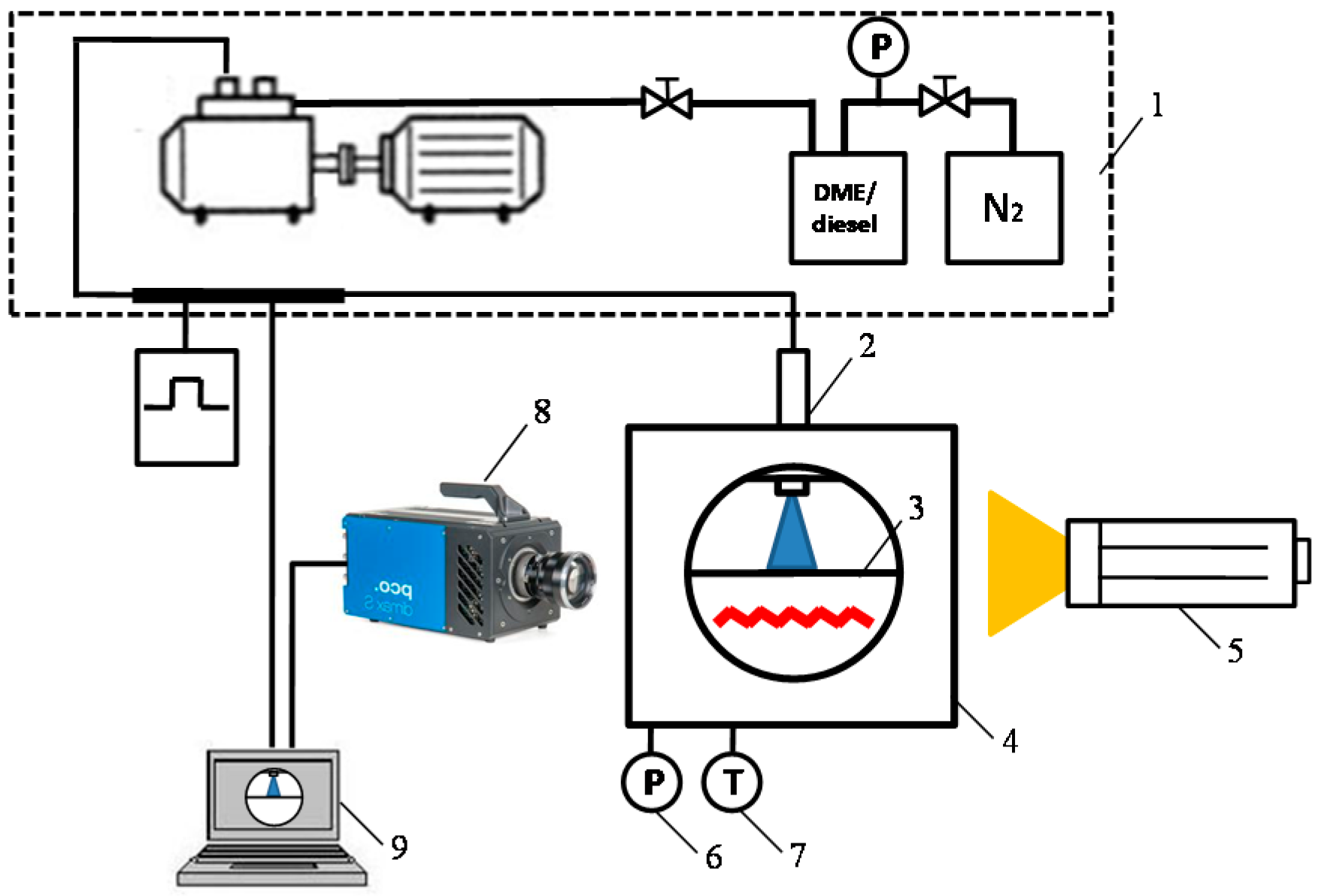
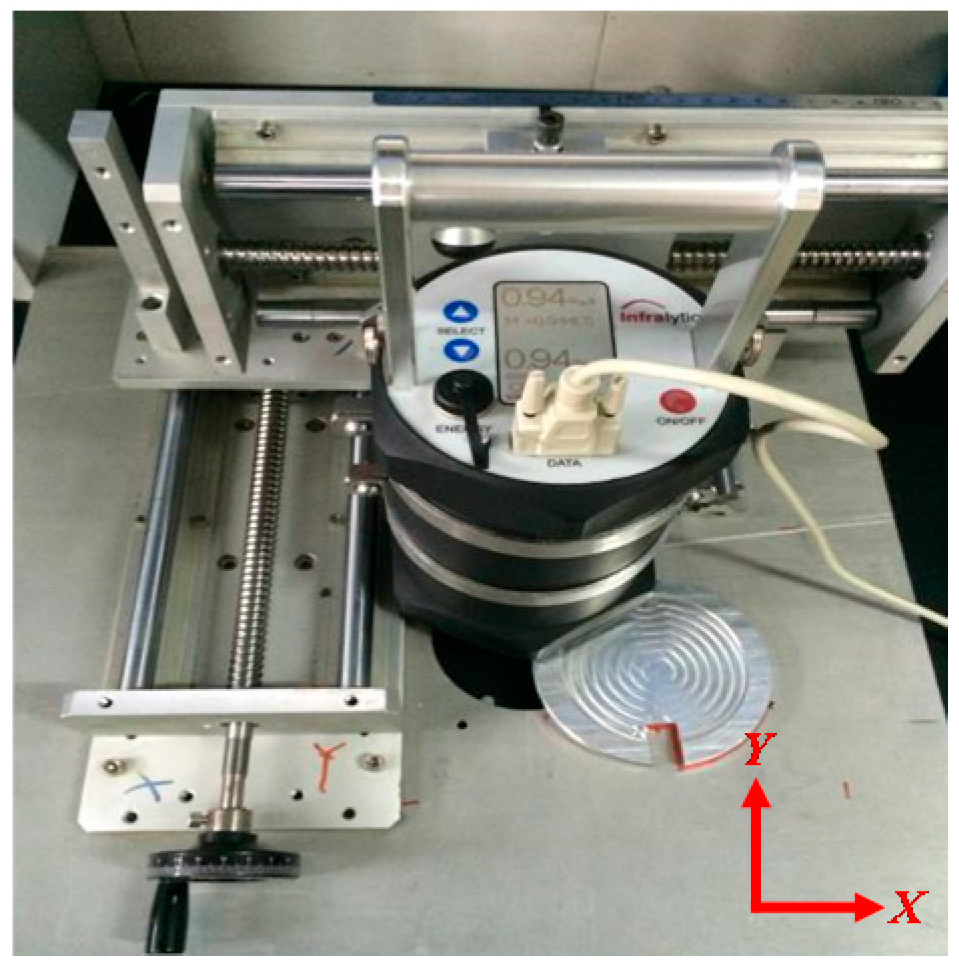

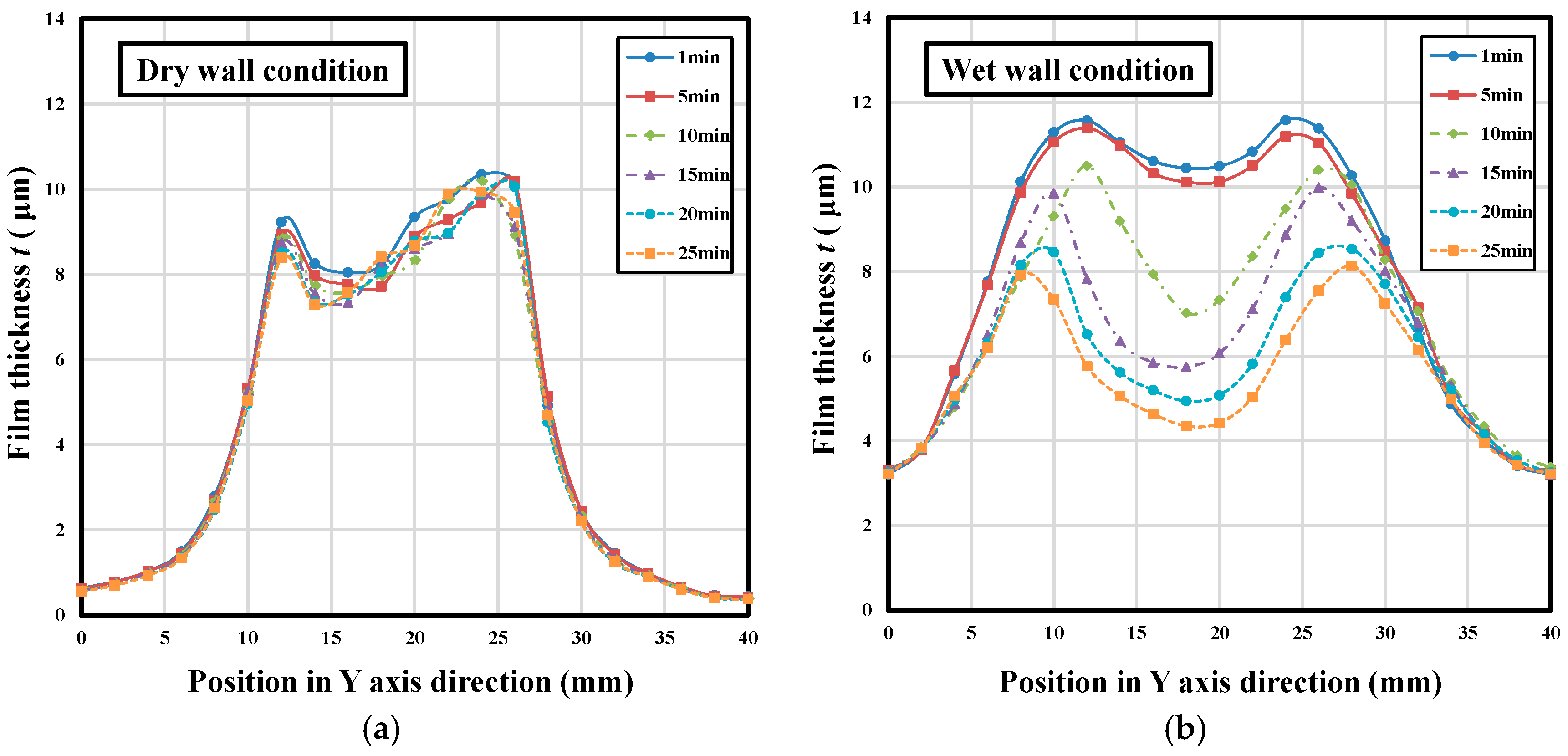
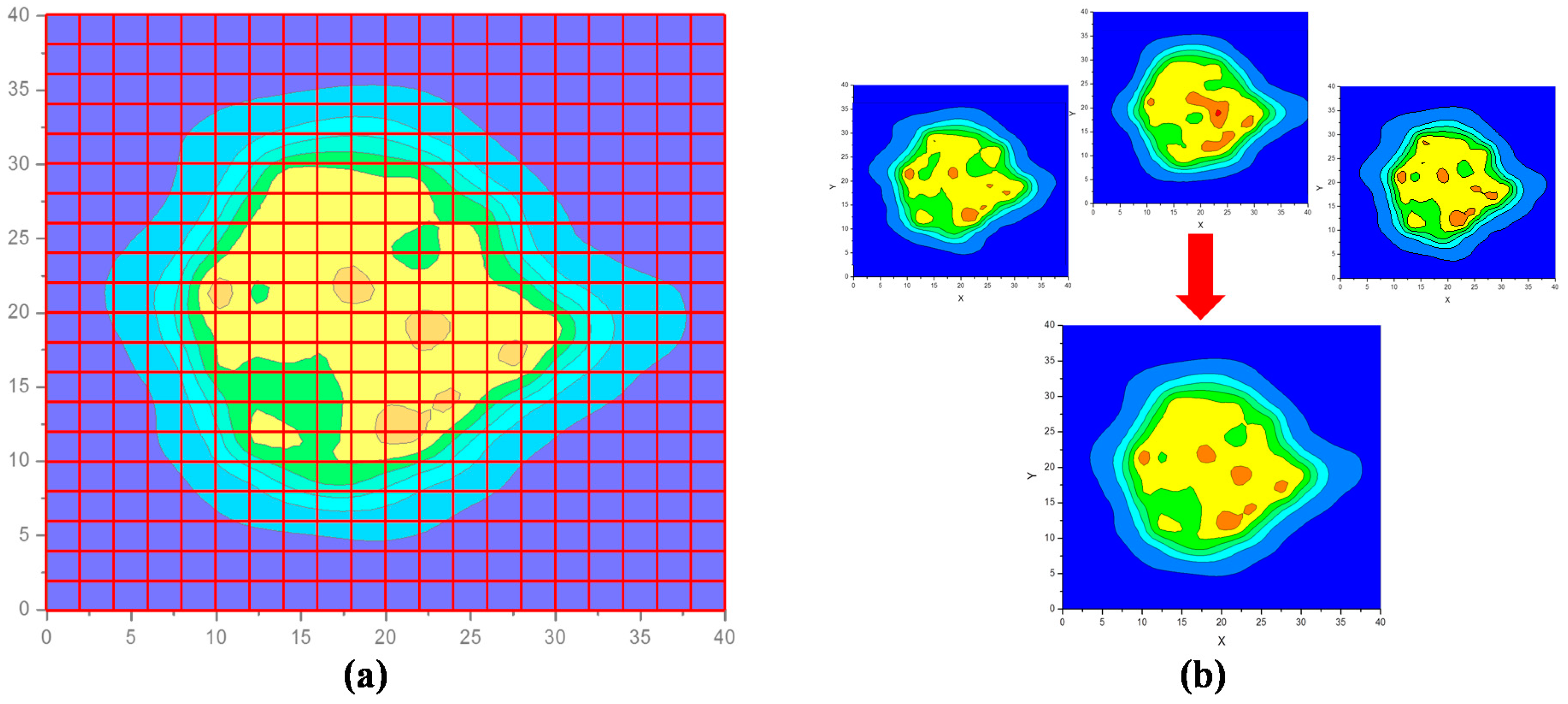
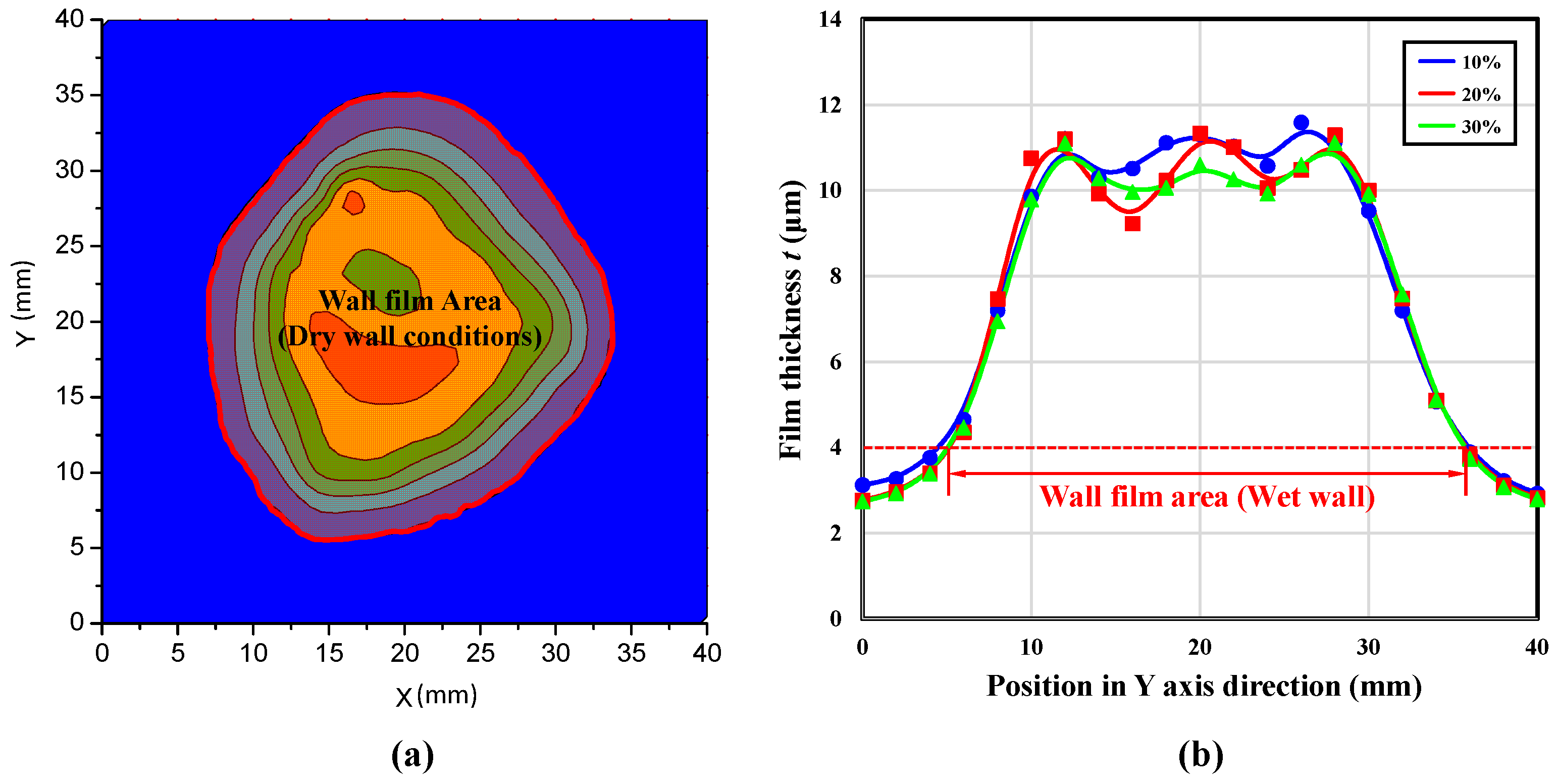
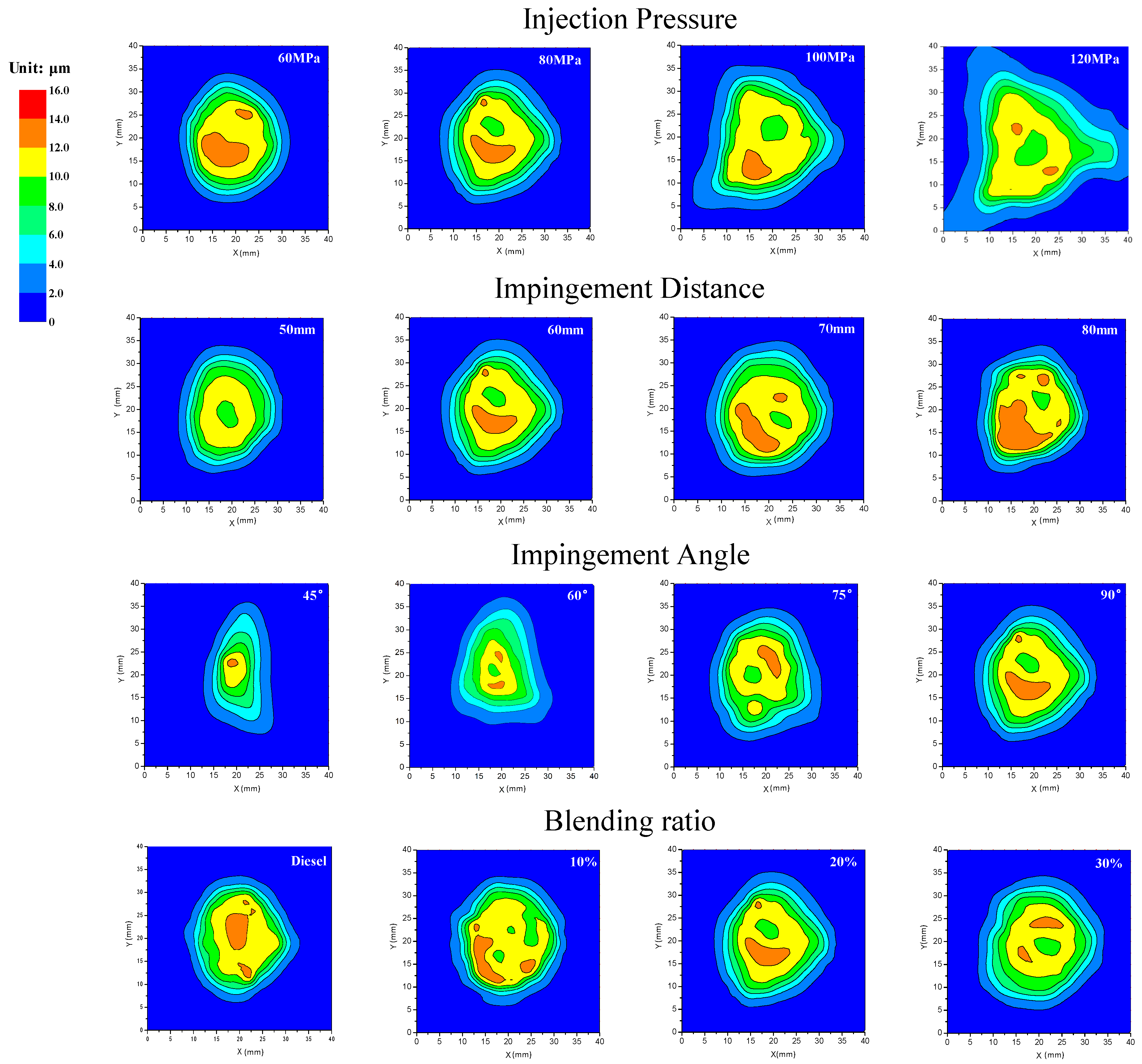




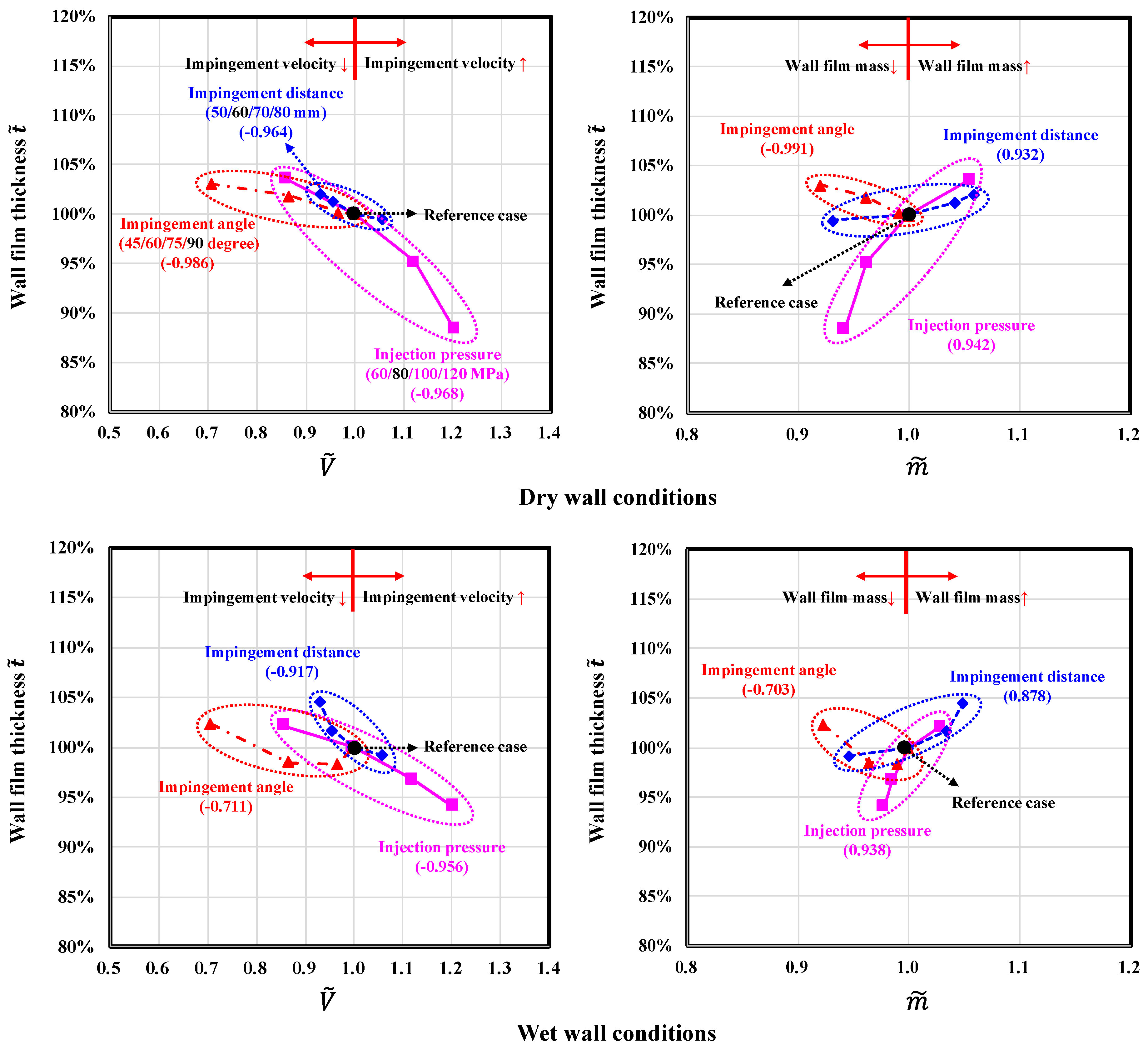
| Physical-Chemical Characteristics | 0# Diesel | DME | Lubricating Oil |
|---|---|---|---|
| Density (kg/m3, 298 K) | 848 | 665 | 856 |
| Kinematic viscosity (mPa·s, 298 K) | 3.8 | 0.16 | 164.6 |
| Surface tension (mN/m, 298 K) | 35.4 | 12.0 | - |
| Saturated Vapour pressure (kPa, 298 K) | 1.9 | 518.5 | - |
| Physical-Chemical Characteristics | Blending Ratio | ||
|---|---|---|---|
| 10% | 20% | 30% | |
| Density (kg/m3, 298 K) | 826 | 804 | 784 |
| Kinematic viscosity (mPa·s, 298 K) | 1.6 | 0.9 | 0.6 |
| Surface tension (mN/m, 298 K) | 32.2 | 29.2 | 26.4 |
| Saturated Vapour pressure (kPa, 298 K) | 138.6 | 233.0 | 302.2 |
| Varying Injection Pressure | ||||
| Impingement distance: 60 mm, Impingement angle: 90°, Blending ratio: 20% | ||||
| Injection pressure (MPa) | 60 | 80 | 100 | 120 |
| Varying Impingement Distance | ||||
| Injection pressure: 80 MPa, Impingement angle: 90°, Blending ratio: 20% | ||||
| Impingement distance (mm) | 50 | 60 | 70 | 80 |
| Varying Impingement Angle | ||||
| Impingement distance: 60 mm, Injection pressure: 80 MPa, Blending ratio: 20% | ||||
| Impingement angle (°) | 45 | 60 | 75 | 90 |
| Varying Blending Ratio | ||||
| Injection pressure: 80 MPa, Impingement distance: 60 mm, Impingement angle: 90° | ||||
| Blending ratio (Mass fraction) | Diesel | 10% | 20% | 30% |
| Injection pressure (MPa) | 60 | 80 | 100 | 120 |
| (m/s) | 181.7 | 211.5 | 237.2 | 254.6 |
| Impingement distance (mm) | 50 | 60 | 70 | 80 |
| (m/s) | 223.6 | 211.5 | 202.2 | 196.7 |
| Impingement angle (°) | 45 | 60 | 75 | 90 |
| (m/s) | 149.5 | 183.2 | 204.3 | 211.5 |
| Blending ratio (Mass fraction) | Diesel | 10% | 20% | 30% |
| (m/s) | 212.7 | 212.2 | 211.5 | 210.7 |
© 2016 by the authors; licensee MDPI, Basel, Switzerland. This article is an open access article distributed under the terms and conditions of the Creative Commons Attribution (CC-BY) license (http://creativecommons.org/licenses/by/4.0/).
Share and Cite
Yu, H.; Liang, X.; Shu, G.; Wang, X.; Wang, Y.; Zhang, H. Experimental Investigation on Wall Film Distribution of Dimethyl Ether/Diesel Blended Fuels Formed during Spray Wall Impingement. Energies 2016, 9, 949. https://doi.org/10.3390/en9110949
Yu H, Liang X, Shu G, Wang X, Wang Y, Zhang H. Experimental Investigation on Wall Film Distribution of Dimethyl Ether/Diesel Blended Fuels Formed during Spray Wall Impingement. Energies. 2016; 9(11):949. https://doi.org/10.3390/en9110949
Chicago/Turabian StyleYu, Hanzhengnan, Xingyu Liang, Gequn Shu, Xu Wang, Yuesen Wang, and Hongsheng Zhang. 2016. "Experimental Investigation on Wall Film Distribution of Dimethyl Ether/Diesel Blended Fuels Formed during Spray Wall Impingement" Energies 9, no. 11: 949. https://doi.org/10.3390/en9110949








